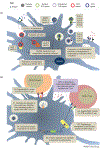Pathogen-associated molecular patterns on biomaterials: a paradigm for engineering new vaccines
- PMID: 21459467
- PMCID: PMC7025712
- DOI: 10.1016/j.tibtech.2011.02.004
Pathogen-associated molecular patterns on biomaterials: a paradigm for engineering new vaccines
Abstract
Vaccine development has progressed significantly and has moved from whole microorganisms to subunit vaccines that contain only their antigenic proteins. Subunit vaccines are often less immunogenic than whole pathogens; therefore, adjuvants must amplify the immune response, ideally establishing both innate and adaptive immunity. Incorporation of antigens into biomaterials, such as liposomes and polymers, can achieve a desired vaccine response. The physical properties of these platforms can be easily manipulated, thus allowing for controlled delivery of immunostimulatory factors and presentation of pathogen-associated molecular patterns (PAMPs) that are targeted to specific immune cells. Targeting antigen to immune cells via PAMP-modified biomaterials is a new strategy to control the subsequent development of immunity and, in turn, effective vaccination. Here, we review the recent advances in both immunology and biomaterial engineering that have brought particulate-based vaccines to reality.
Copyright © 2011 Elsevier Ltd. All rights reserved.
Figures


Similar articles
-
Immunological Mechanism and Clinical Application of PAMP Adjuvants.Recent Pat Anticancer Drug Discov. 2021;16(1):30-43. doi: 10.2174/1574892816666210201114712. Recent Pat Anticancer Drug Discov. 2021. PMID: 33563182 Review.
-
Recent developments in adjuvants for vaccines against infectious diseases.Biomol Eng. 2001 Oct 15;18(3):69-85. doi: 10.1016/s1389-0344(01)00101-0. Biomol Eng. 2001. PMID: 11566599 Review.
-
Targeting Syk-Card9-activating C-type lectin receptors by vaccine adjuvants: findings, implications and open questions.Immunobiology. 2011 Nov;216(11):1184-91. doi: 10.1016/j.imbio.2011.06.005. Epub 2011 Jun 21. Immunobiology. 2011. PMID: 21742403 Review.
-
Recent developments in vaccine delivery systems.Curr Drug Targets Infect Disord. 2001 Nov;1(3):273-86. doi: 10.2174/1568005014606008. Curr Drug Targets Infect Disord. 2001. PMID: 12455401 Review.
-
Trends in adjuvant development for vaccines: DAMPs and PAMPs as potential new adjuvants.Braz J Med Biol Res. 2011 Jun;44(6):500-13. doi: 10.1590/s0100-879x2011007500064. Epub 2011 May 13. Braz J Med Biol Res. 2011. PMID: 21584443 Review.
Cited by
-
Microbe-host interactions: structure and functions of Gram-negative bacterial membrane vesicles.Front Microbiol. 2023 Aug 31;14:1225513. doi: 10.3389/fmicb.2023.1225513. eCollection 2023. Front Microbiol. 2023. PMID: 37720140 Free PMC article. Review.
-
Role of Damage-Associated Molecular Pattern/Cell Death Pathways in Vaccine-Induced Immunity.Viruses. 2021 Nov 23;13(12):2340. doi: 10.3390/v13122340. Viruses. 2021. PMID: 34960608 Free PMC article. Review.
-
Muscularis macrophages controlled by NLRP3 maintain the homeostasis of excitatory neurons.Int J Biol Sci. 2024 Apr 15;20(7):2476-2490. doi: 10.7150/ijbs.91389. eCollection 2024. Int J Biol Sci. 2024. PMID: 38725863 Free PMC article.
-
Nanovaccine Delivery Approaches and Advanced Delivery Systems for the Prevention of Viral Infections: From Development to Clinical Application.Pharmaceutics. 2021 Dec 5;13(12):2091. doi: 10.3390/pharmaceutics13122091. Pharmaceutics. 2021. PMID: 34959372 Free PMC article. Review.
-
Co-delivery of Dual Toll-Like Receptor Agonists and Antigen in Poly(Lactic-Co-Glycolic) Acid/Polyethylenimine Cationic Hybrid Nanoparticles Promote Efficient In Vivo Immune Responses.Front Immunol. 2017 Sep 13;8:1077. doi: 10.3389/fimmu.2017.01077. eCollection 2017. Front Immunol. 2017. PMID: 28955328 Free PMC article.
References
-
- Steinman RM (2001) Dendritic cells and the control of immunity: enhancing the efficiency of antigen presentation. Mt. Sinai J. Med., N.Y 68, 160–166 - PubMed
-
- Geijtenbeek TB et al. (2000) DC-SIGN, a dendritic cell-specific HIV1-binding protein that enhances trans-infection of T cells. Cell 100, 587–597 - PubMed
-
- Baylor NW et al. (2002) Aluminum salts in vaccines—US perspective. Vaccine 20 (Suppl. 3), S18–23 - PubMed
Publication types
MeSH terms
Substances
Grants and funding
LinkOut - more resources
Full Text Sources
Other Literature Sources
Medical

